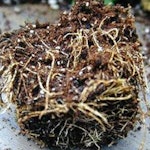 Be Inspired Blog - Arizona
Be Inspired Blog - Arizona

How Important Is A Strong Root Structure?
It's everything.
Simply put, healthy plants have healthy roots. In fact, half of the secret to growing beautiful plants is healthy roots.
Healthy, fleshy, abundant roots:
- Support the growth of those fantastic flowers and lush, glossy foliage.
- Knit soil that might otherwise be washed away during heavy rains.
- Facilitate better uptake of water and nutrients, two of the most critical resources a plant needs.
- Produce stronger stems and foliage that better withstand environmental stress, especially in challenging climates.
While there’s much you can do to keep roots healthy (see below), you’ll be locked in an eternal battle if your plant comes home with roots that are too few, too small, or not healthy. Top growth such as lots of deep green leaves, buds, and flowers are an indication that you’re plant is in great condition, but it pays to take a peek at the roots, too. Beginning with a plant that’s exceptional from bottom to top is the best way to start off right.
 Define “healthy roots?”
Define “healthy roots?”
Next time you’re at a nursery, gently turn a pot over and take a look. Roots that are white or tan colored, succulent when you squeeze them and have fleshy white tips, are indications that the root system is healthy. Roots that are brown, soft, and fall apart easily are clues that the root system is not optimal.
How Can I Maintain My Healthy Roots?
So, now that healthy, well-rooted plant is at your home and you have just the place for it. Exciting! Let’s keep it in tip-top shape, starting with the roots.
- Water deeply and thoroughly only when its needed. “Needed”, huh? Okay, this is a two part answer. Too much water suffocates and rots roots and discourages them from drilling down into the soil to find their own source of water; to little water, especially for newly planted specimens risks drying out roots before they can get settled in. So, plants need more frequent (but shorter) watering when they are first planted. Depending on your climate and conditions this could mean a quick drink daily or every other day. For established plants, this means waiting until you see the surface of the soil begin to change color from dark to light then watering deeply but infrequently. For containers, you need to be a bit more vigilant, but also more careful, as a waterlogged pot is sure to be an issue. We highly recommend a $10.00 moisture meter that can be bought at any hardware store.
- Feed your soil so it can feed your plants. Regular applications of organic materials such as compost not only provide nutrients, but improves tilth and aeration helping keep roots healthy.
- Be gentle when planting, relocating, or repotting so as not to disturb or break roots.
- Adding a 2-3 inch layer of mulch after planting can help keep roots cool and moist and prevent weed growth at the same time. Weeds compete with your newly planted specimens for water and nutrients. Smother them!

